HSH769 Comparative Health Systems: Healthcare in Burundi
VerifiedAdded on 2023/06/04
|14
|4093
|195
Report
AI Summary
This report provides a comprehensive analysis of the healthcare system in Burundi, highlighting the challenges it faces due to factors such as political instability, economic constraints, and socio-cultural influences. The report delves into the impact of civil wars, corruption, and inadequate infrastructure on healthcare delivery. It also examines the role of social-cultural factors, including the use of traditional medicine and high population growth, on the health system. Furthermore, the report discusses institutional factors such as the establishment of health insurance and training institutions, while also acknowledging the weaknesses in public sector governance. The report concludes by suggesting lessons Burundi can learn from other countries to improve its healthcare system, emphasizing the importance of national policies, strong implementation strategies, and investment in information systems. This student-contributed assignment is available on Desklib, a platform offering study tools and resources for students.

HEALTHCARE SYSTEM OF BURUNDI 1
HEALTH CARE SYSTEM OF BURUNDI
By (Name)
The Name of the Class (Course)
Professor
The Name of the School
The City and State where it is located
The Date
HEALTH CARE SYSTEM OF BURUNDI
By (Name)
The Name of the Class (Course)
Professor
The Name of the School
The City and State where it is located
The Date
Paraphrase This Document
Need a fresh take? Get an instant paraphrase of this document with our AI Paraphraser
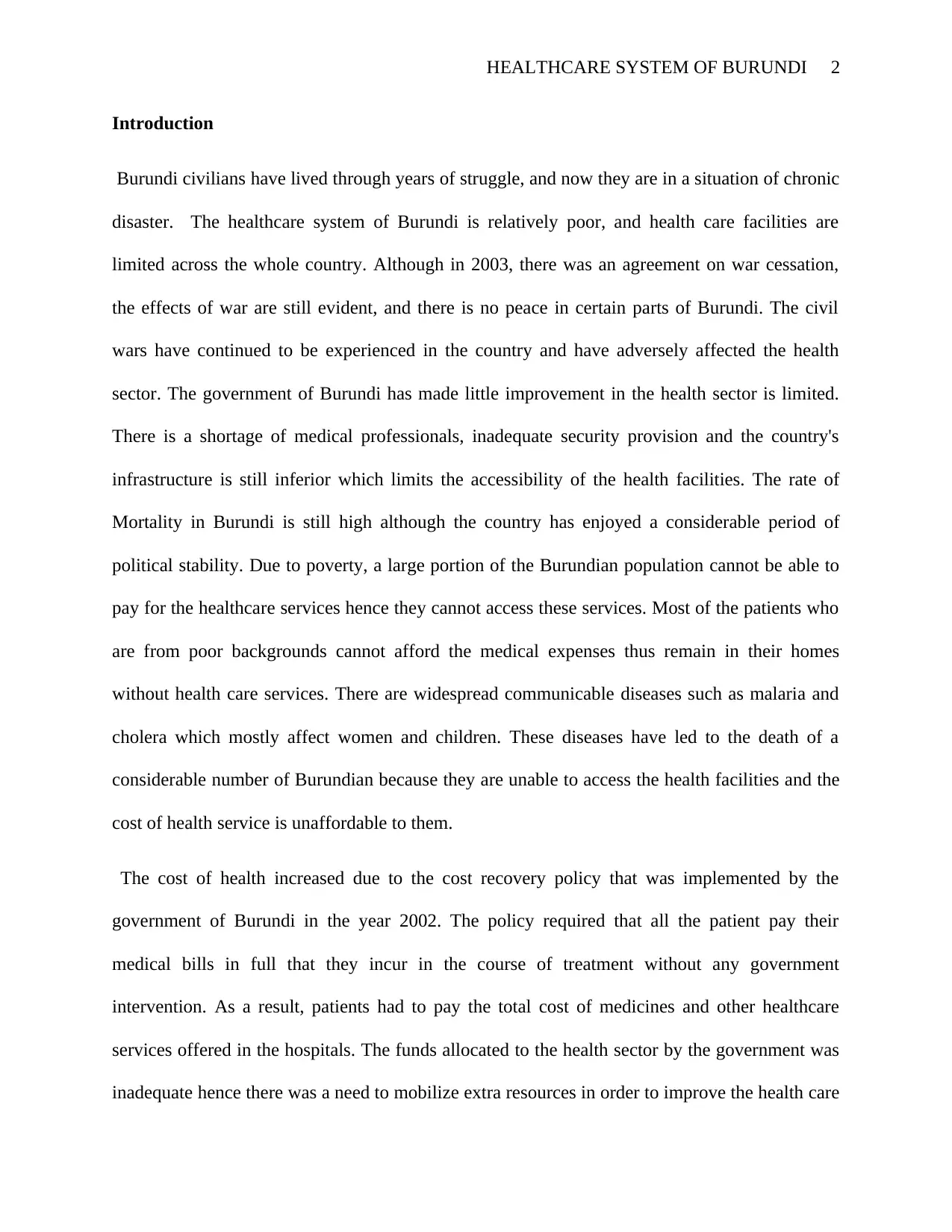
HEALTHCARE SYSTEM OF BURUNDI 2
Introduction
Burundi civilians have lived through years of struggle, and now they are in a situation of chronic
disaster. The healthcare system of Burundi is relatively poor, and health care facilities are
limited across the whole country. Although in 2003, there was an agreement on war cessation,
the effects of war are still evident, and there is no peace in certain parts of Burundi. The civil
wars have continued to be experienced in the country and have adversely affected the health
sector. The government of Burundi has made little improvement in the health sector is limited.
There is a shortage of medical professionals, inadequate security provision and the country's
infrastructure is still inferior which limits the accessibility of the health facilities. The rate of
Mortality in Burundi is still high although the country has enjoyed a considerable period of
political stability. Due to poverty, a large portion of the Burundian population cannot be able to
pay for the healthcare services hence they cannot access these services. Most of the patients who
are from poor backgrounds cannot afford the medical expenses thus remain in their homes
without health care services. There are widespread communicable diseases such as malaria and
cholera which mostly affect women and children. These diseases have led to the death of a
considerable number of Burundian because they are unable to access the health facilities and the
cost of health service is unaffordable to them.
The cost of health increased due to the cost recovery policy that was implemented by the
government of Burundi in the year 2002. The policy required that all the patient pay their
medical bills in full that they incur in the course of treatment without any government
intervention. As a result, patients had to pay the total cost of medicines and other healthcare
services offered in the hospitals. The funds allocated to the health sector by the government was
inadequate hence there was a need to mobilize extra resources in order to improve the health care
Introduction
Burundi civilians have lived through years of struggle, and now they are in a situation of chronic
disaster. The healthcare system of Burundi is relatively poor, and health care facilities are
limited across the whole country. Although in 2003, there was an agreement on war cessation,
the effects of war are still evident, and there is no peace in certain parts of Burundi. The civil
wars have continued to be experienced in the country and have adversely affected the health
sector. The government of Burundi has made little improvement in the health sector is limited.
There is a shortage of medical professionals, inadequate security provision and the country's
infrastructure is still inferior which limits the accessibility of the health facilities. The rate of
Mortality in Burundi is still high although the country has enjoyed a considerable period of
political stability. Due to poverty, a large portion of the Burundian population cannot be able to
pay for the healthcare services hence they cannot access these services. Most of the patients who
are from poor backgrounds cannot afford the medical expenses thus remain in their homes
without health care services. There are widespread communicable diseases such as malaria and
cholera which mostly affect women and children. These diseases have led to the death of a
considerable number of Burundian because they are unable to access the health facilities and the
cost of health service is unaffordable to them.
The cost of health increased due to the cost recovery policy that was implemented by the
government of Burundi in the year 2002. The policy required that all the patient pay their
medical bills in full that they incur in the course of treatment without any government
intervention. As a result, patients had to pay the total cost of medicines and other healthcare
services offered in the hospitals. The funds allocated to the health sector by the government was
inadequate hence there was a need to mobilize extra resources in order to improve the health care

HEALTHCARE SYSTEM OF BURUNDI 3
services. Up to this point, Burundi has introduced two crucial reforms in the health sector to aid
in the improvement of health care. These reforms include performance-based financing reforms
for the hospitals that offer health care services and a district health system to enable in
disseminating healthcare facilities (Van Lerberghe et al, 2014).
The government of Burundi and private sector are have recently put in place strategies to
improve the health sector in Burundi. They have improved the supply of medicine to the public
through increasing the quantity and quality of the medication availed to the public. The drugs are
distributed to the vast population of Burundi through private and public sector at an affordable
price. However, the health sector of Burundi is facing several challenges which include;
inadequate infrastructure, low doctor-to-patient ratio, limitation of access and use of health
services, and inadequate reference care in health facilities. In addition, the health sector also
faces challenges like adequate public funding, shortage of qualified personnel, and limited access
to health services due to financial constraint among the poor. Other challenges include
inadequate logistics, lack of vital registration system to use for data capturing on the prevailing
trends and rate mortality, and also the health centers are inaccessible due to the geographical
factors. The government is looking for ways to lower mortality due to communicable diseases,
reduced neonatal and maternal care, and reduced child and infant care (Farag et al 2013).
Factors influencing health care system in Burundi
Several factors affect the healthcare system of Burundi. These factors can be classified as
economic, institutional, political and social-cultural factors. Health system in any setting is solely
influenced by these factors. The success of the health system greatly depends on the integration
of these factors and how careful the stakeholder considers them. These factors are discussed in
details in the following section (Swartz et al, 2014).
services. Up to this point, Burundi has introduced two crucial reforms in the health sector to aid
in the improvement of health care. These reforms include performance-based financing reforms
for the hospitals that offer health care services and a district health system to enable in
disseminating healthcare facilities (Van Lerberghe et al, 2014).
The government of Burundi and private sector are have recently put in place strategies to
improve the health sector in Burundi. They have improved the supply of medicine to the public
through increasing the quantity and quality of the medication availed to the public. The drugs are
distributed to the vast population of Burundi through private and public sector at an affordable
price. However, the health sector of Burundi is facing several challenges which include;
inadequate infrastructure, low doctor-to-patient ratio, limitation of access and use of health
services, and inadequate reference care in health facilities. In addition, the health sector also
faces challenges like adequate public funding, shortage of qualified personnel, and limited access
to health services due to financial constraint among the poor. Other challenges include
inadequate logistics, lack of vital registration system to use for data capturing on the prevailing
trends and rate mortality, and also the health centers are inaccessible due to the geographical
factors. The government is looking for ways to lower mortality due to communicable diseases,
reduced neonatal and maternal care, and reduced child and infant care (Farag et al 2013).
Factors influencing health care system in Burundi
Several factors affect the healthcare system of Burundi. These factors can be classified as
economic, institutional, political and social-cultural factors. Health system in any setting is solely
influenced by these factors. The success of the health system greatly depends on the integration
of these factors and how careful the stakeholder considers them. These factors are discussed in
details in the following section (Swartz et al, 2014).
⊘ This is a preview!⊘
Do you want full access?
Subscribe today to unlock all pages.

Trusted by 1+ million students worldwide
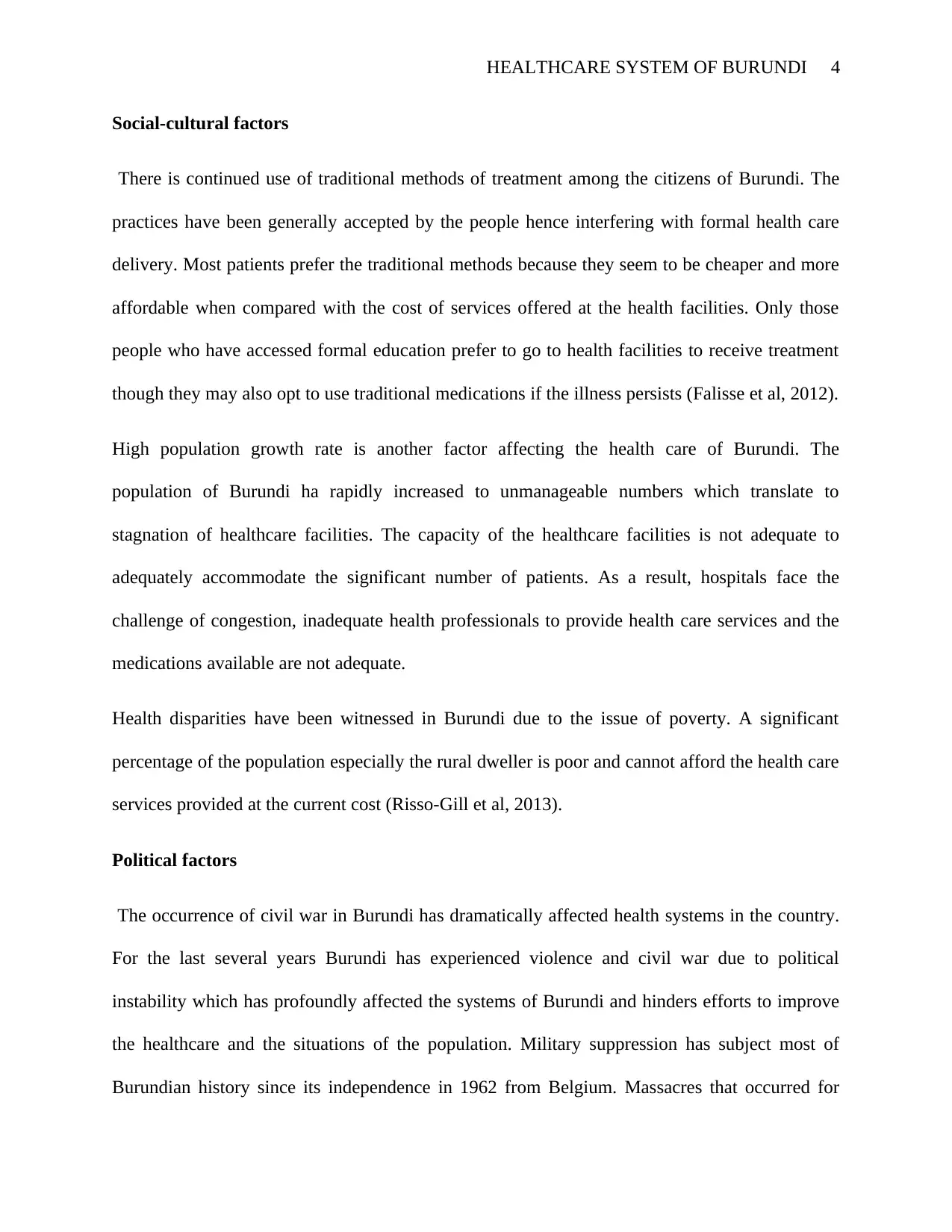
HEALTHCARE SYSTEM OF BURUNDI 4
Social-cultural factors
There is continued use of traditional methods of treatment among the citizens of Burundi. The
practices have been generally accepted by the people hence interfering with formal health care
delivery. Most patients prefer the traditional methods because they seem to be cheaper and more
affordable when compared with the cost of services offered at the health facilities. Only those
people who have accessed formal education prefer to go to health facilities to receive treatment
though they may also opt to use traditional medications if the illness persists (Falisse et al, 2012).
High population growth rate is another factor affecting the health care of Burundi. The
population of Burundi ha rapidly increased to unmanageable numbers which translate to
stagnation of healthcare facilities. The capacity of the healthcare facilities is not adequate to
adequately accommodate the significant number of patients. As a result, hospitals face the
challenge of congestion, inadequate health professionals to provide health care services and the
medications available are not adequate.
Health disparities have been witnessed in Burundi due to the issue of poverty. A significant
percentage of the population especially the rural dweller is poor and cannot afford the health care
services provided at the current cost (Risso-Gill et al, 2013).
Political factors
The occurrence of civil war in Burundi has dramatically affected health systems in the country.
For the last several years Burundi has experienced violence and civil war due to political
instability which has profoundly affected the systems of Burundi and hinders efforts to improve
the healthcare and the situations of the population. Military suppression has subject most of
Burundian history since its independence in 1962 from Belgium. Massacres that occurred for
Social-cultural factors
There is continued use of traditional methods of treatment among the citizens of Burundi. The
practices have been generally accepted by the people hence interfering with formal health care
delivery. Most patients prefer the traditional methods because they seem to be cheaper and more
affordable when compared with the cost of services offered at the health facilities. Only those
people who have accessed formal education prefer to go to health facilities to receive treatment
though they may also opt to use traditional medications if the illness persists (Falisse et al, 2012).
High population growth rate is another factor affecting the health care of Burundi. The
population of Burundi ha rapidly increased to unmanageable numbers which translate to
stagnation of healthcare facilities. The capacity of the healthcare facilities is not adequate to
adequately accommodate the significant number of patients. As a result, hospitals face the
challenge of congestion, inadequate health professionals to provide health care services and the
medications available are not adequate.
Health disparities have been witnessed in Burundi due to the issue of poverty. A significant
percentage of the population especially the rural dweller is poor and cannot afford the health care
services provided at the current cost (Risso-Gill et al, 2013).
Political factors
The occurrence of civil war in Burundi has dramatically affected health systems in the country.
For the last several years Burundi has experienced violence and civil war due to political
instability which has profoundly affected the systems of Burundi and hinders efforts to improve
the healthcare and the situations of the population. Military suppression has subject most of
Burundian history since its independence in 1962 from Belgium. Massacres that occurred for
Paraphrase This Document
Need a fresh take? Get an instant paraphrase of this document with our AI Paraphraser
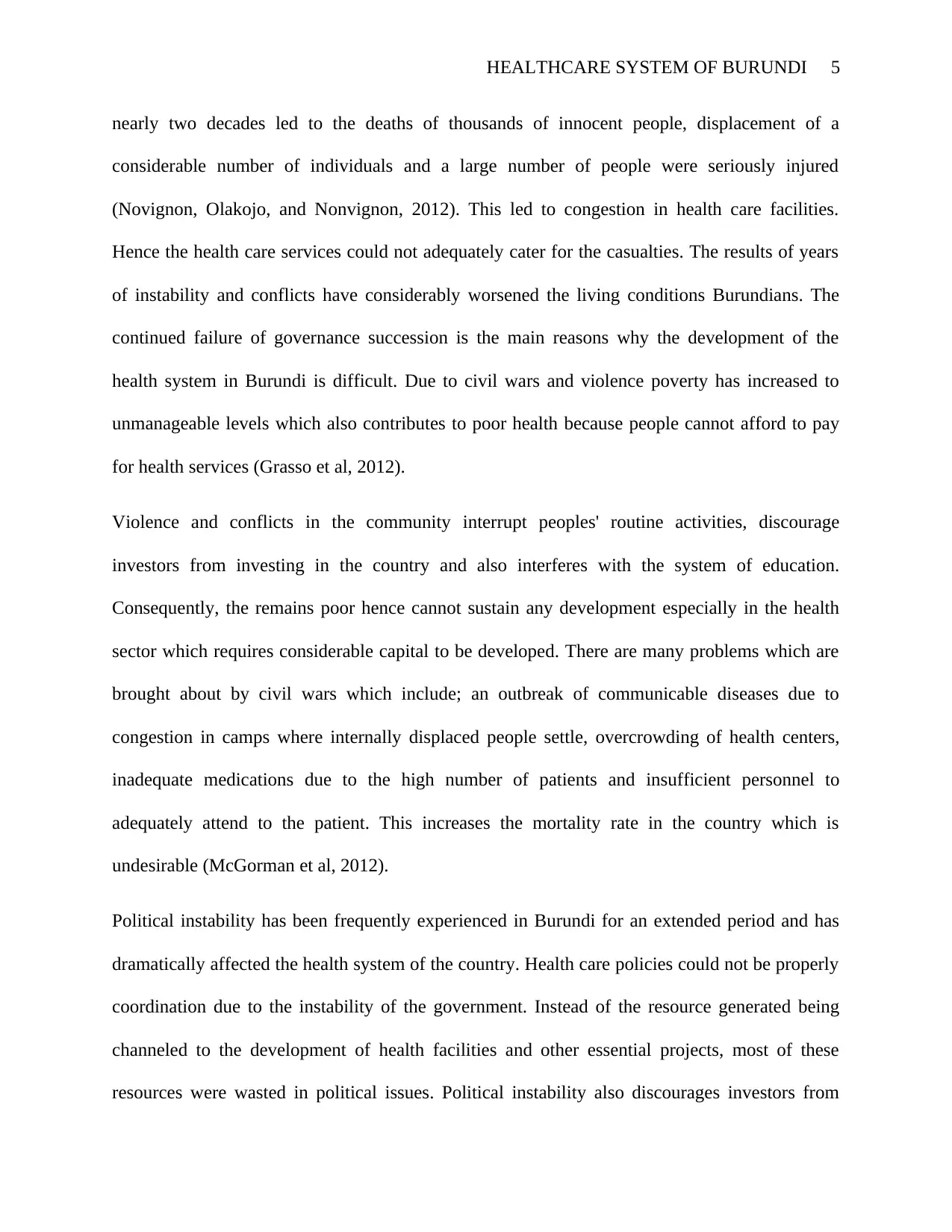
HEALTHCARE SYSTEM OF BURUNDI 5
nearly two decades led to the deaths of thousands of innocent people, displacement of a
considerable number of individuals and a large number of people were seriously injured
(Novignon, Olakojo, and Nonvignon, 2012). This led to congestion in health care facilities.
Hence the health care services could not adequately cater for the casualties. The results of years
of instability and conflicts have considerably worsened the living conditions Burundians. The
continued failure of governance succession is the main reasons why the development of the
health system in Burundi is difficult. Due to civil wars and violence poverty has increased to
unmanageable levels which also contributes to poor health because people cannot afford to pay
for health services (Grasso et al, 2012).
Violence and conflicts in the community interrupt peoples' routine activities, discourage
investors from investing in the country and also interferes with the system of education.
Consequently, the remains poor hence cannot sustain any development especially in the health
sector which requires considerable capital to be developed. There are many problems which are
brought about by civil wars which include; an outbreak of communicable diseases due to
congestion in camps where internally displaced people settle, overcrowding of health centers,
inadequate medications due to the high number of patients and insufficient personnel to
adequately attend to the patient. This increases the mortality rate in the country which is
undesirable (McGorman et al, 2012).
Political instability has been frequently experienced in Burundi for an extended period and has
dramatically affected the health system of the country. Health care policies could not be properly
coordination due to the instability of the government. Instead of the resource generated being
channeled to the development of health facilities and other essential projects, most of these
resources were wasted in political issues. Political instability also discourages investors from
nearly two decades led to the deaths of thousands of innocent people, displacement of a
considerable number of individuals and a large number of people were seriously injured
(Novignon, Olakojo, and Nonvignon, 2012). This led to congestion in health care facilities.
Hence the health care services could not adequately cater for the casualties. The results of years
of instability and conflicts have considerably worsened the living conditions Burundians. The
continued failure of governance succession is the main reasons why the development of the
health system in Burundi is difficult. Due to civil wars and violence poverty has increased to
unmanageable levels which also contributes to poor health because people cannot afford to pay
for health services (Grasso et al, 2012).
Violence and conflicts in the community interrupt peoples' routine activities, discourage
investors from investing in the country and also interferes with the system of education.
Consequently, the remains poor hence cannot sustain any development especially in the health
sector which requires considerable capital to be developed. There are many problems which are
brought about by civil wars which include; an outbreak of communicable diseases due to
congestion in camps where internally displaced people settle, overcrowding of health centers,
inadequate medications due to the high number of patients and insufficient personnel to
adequately attend to the patient. This increases the mortality rate in the country which is
undesirable (McGorman et al, 2012).
Political instability has been frequently experienced in Burundi for an extended period and has
dramatically affected the health system of the country. Health care policies could not be properly
coordination due to the instability of the government. Instead of the resource generated being
channeled to the development of health facilities and other essential projects, most of these
resources were wasted in political issues. Political instability also discourages investors from
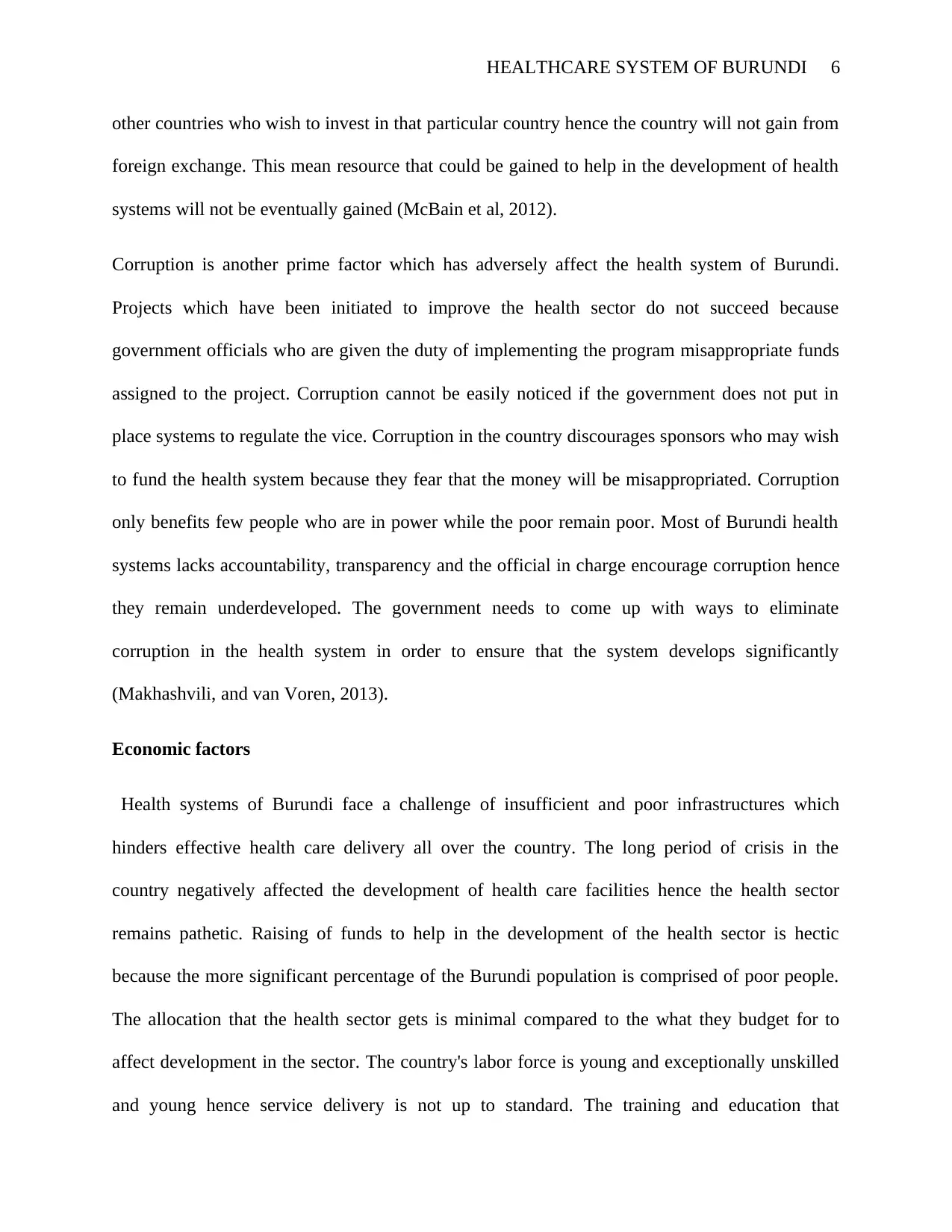
HEALTHCARE SYSTEM OF BURUNDI 6
other countries who wish to invest in that particular country hence the country will not gain from
foreign exchange. This mean resource that could be gained to help in the development of health
systems will not be eventually gained (McBain et al, 2012).
Corruption is another prime factor which has adversely affect the health system of Burundi.
Projects which have been initiated to improve the health sector do not succeed because
government officials who are given the duty of implementing the program misappropriate funds
assigned to the project. Corruption cannot be easily noticed if the government does not put in
place systems to regulate the vice. Corruption in the country discourages sponsors who may wish
to fund the health system because they fear that the money will be misappropriated. Corruption
only benefits few people who are in power while the poor remain poor. Most of Burundi health
systems lacks accountability, transparency and the official in charge encourage corruption hence
they remain underdeveloped. The government needs to come up with ways to eliminate
corruption in the health system in order to ensure that the system develops significantly
(Makhashvili, and van Voren, 2013).
Economic factors
Health systems of Burundi face a challenge of insufficient and poor infrastructures which
hinders effective health care delivery all over the country. The long period of crisis in the
country negatively affected the development of health care facilities hence the health sector
remains pathetic. Raising of funds to help in the development of the health sector is hectic
because the more significant percentage of the Burundi population is comprised of poor people.
The allocation that the health sector gets is minimal compared to the what they budget for to
affect development in the sector. The country's labor force is young and exceptionally unskilled
and young hence service delivery is not up to standard. The training and education that
other countries who wish to invest in that particular country hence the country will not gain from
foreign exchange. This mean resource that could be gained to help in the development of health
systems will not be eventually gained (McBain et al, 2012).
Corruption is another prime factor which has adversely affect the health system of Burundi.
Projects which have been initiated to improve the health sector do not succeed because
government officials who are given the duty of implementing the program misappropriate funds
assigned to the project. Corruption cannot be easily noticed if the government does not put in
place systems to regulate the vice. Corruption in the country discourages sponsors who may wish
to fund the health system because they fear that the money will be misappropriated. Corruption
only benefits few people who are in power while the poor remain poor. Most of Burundi health
systems lacks accountability, transparency and the official in charge encourage corruption hence
they remain underdeveloped. The government needs to come up with ways to eliminate
corruption in the health system in order to ensure that the system develops significantly
(Makhashvili, and van Voren, 2013).
Economic factors
Health systems of Burundi face a challenge of insufficient and poor infrastructures which
hinders effective health care delivery all over the country. The long period of crisis in the
country negatively affected the development of health care facilities hence the health sector
remains pathetic. Raising of funds to help in the development of the health sector is hectic
because the more significant percentage of the Burundi population is comprised of poor people.
The allocation that the health sector gets is minimal compared to the what they budget for to
affect development in the sector. The country's labor force is young and exceptionally unskilled
and young hence service delivery is not up to standard. The training and education that
⊘ This is a preview!⊘
Do you want full access?
Subscribe today to unlock all pages.

Trusted by 1+ million students worldwide
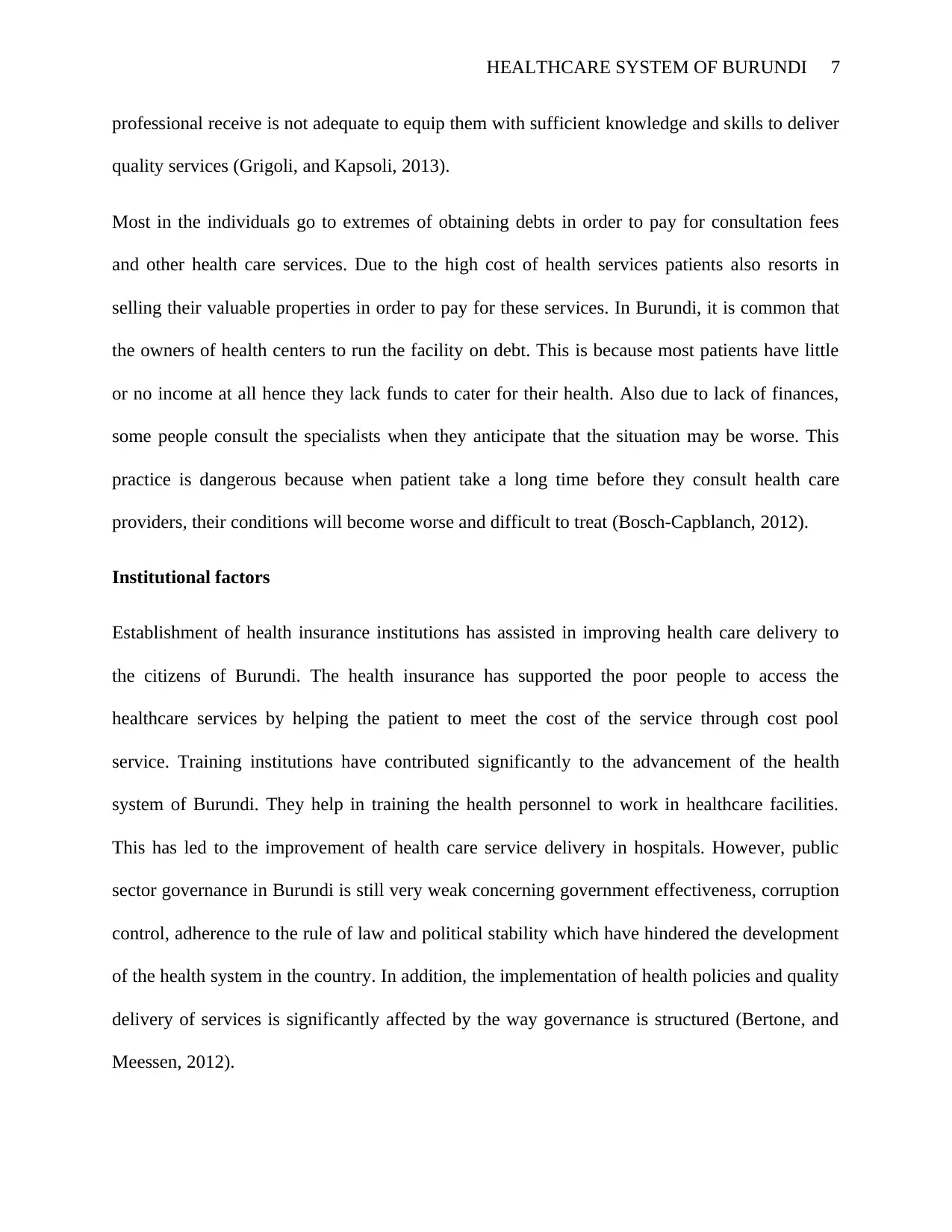
HEALTHCARE SYSTEM OF BURUNDI 7
professional receive is not adequate to equip them with sufficient knowledge and skills to deliver
quality services (Grigoli, and Kapsoli, 2013).
Most in the individuals go to extremes of obtaining debts in order to pay for consultation fees
and other health care services. Due to the high cost of health services patients also resorts in
selling their valuable properties in order to pay for these services. In Burundi, it is common that
the owners of health centers to run the facility on debt. This is because most patients have little
or no income at all hence they lack funds to cater for their health. Also due to lack of finances,
some people consult the specialists when they anticipate that the situation may be worse. This
practice is dangerous because when patient take a long time before they consult health care
providers, their conditions will become worse and difficult to treat (Bosch-Capblanch, 2012).
Institutional factors
Establishment of health insurance institutions has assisted in improving health care delivery to
the citizens of Burundi. The health insurance has supported the poor people to access the
healthcare services by helping the patient to meet the cost of the service through cost pool
service. Training institutions have contributed significantly to the advancement of the health
system of Burundi. They help in training the health personnel to work in healthcare facilities.
This has led to the improvement of health care service delivery in hospitals. However, public
sector governance in Burundi is still very weak concerning government effectiveness, corruption
control, adherence to the rule of law and political stability which have hindered the development
of the health system in the country. In addition, the implementation of health policies and quality
delivery of services is significantly affected by the way governance is structured (Bertone, and
Meessen, 2012).
professional receive is not adequate to equip them with sufficient knowledge and skills to deliver
quality services (Grigoli, and Kapsoli, 2013).
Most in the individuals go to extremes of obtaining debts in order to pay for consultation fees
and other health care services. Due to the high cost of health services patients also resorts in
selling their valuable properties in order to pay for these services. In Burundi, it is common that
the owners of health centers to run the facility on debt. This is because most patients have little
or no income at all hence they lack funds to cater for their health. Also due to lack of finances,
some people consult the specialists when they anticipate that the situation may be worse. This
practice is dangerous because when patient take a long time before they consult health care
providers, their conditions will become worse and difficult to treat (Bosch-Capblanch, 2012).
Institutional factors
Establishment of health insurance institutions has assisted in improving health care delivery to
the citizens of Burundi. The health insurance has supported the poor people to access the
healthcare services by helping the patient to meet the cost of the service through cost pool
service. Training institutions have contributed significantly to the advancement of the health
system of Burundi. They help in training the health personnel to work in healthcare facilities.
This has led to the improvement of health care service delivery in hospitals. However, public
sector governance in Burundi is still very weak concerning government effectiveness, corruption
control, adherence to the rule of law and political stability which have hindered the development
of the health system in the country. In addition, the implementation of health policies and quality
delivery of services is significantly affected by the way governance is structured (Bertone, and
Meessen, 2012).
Paraphrase This Document
Need a fresh take? Get an instant paraphrase of this document with our AI Paraphraser
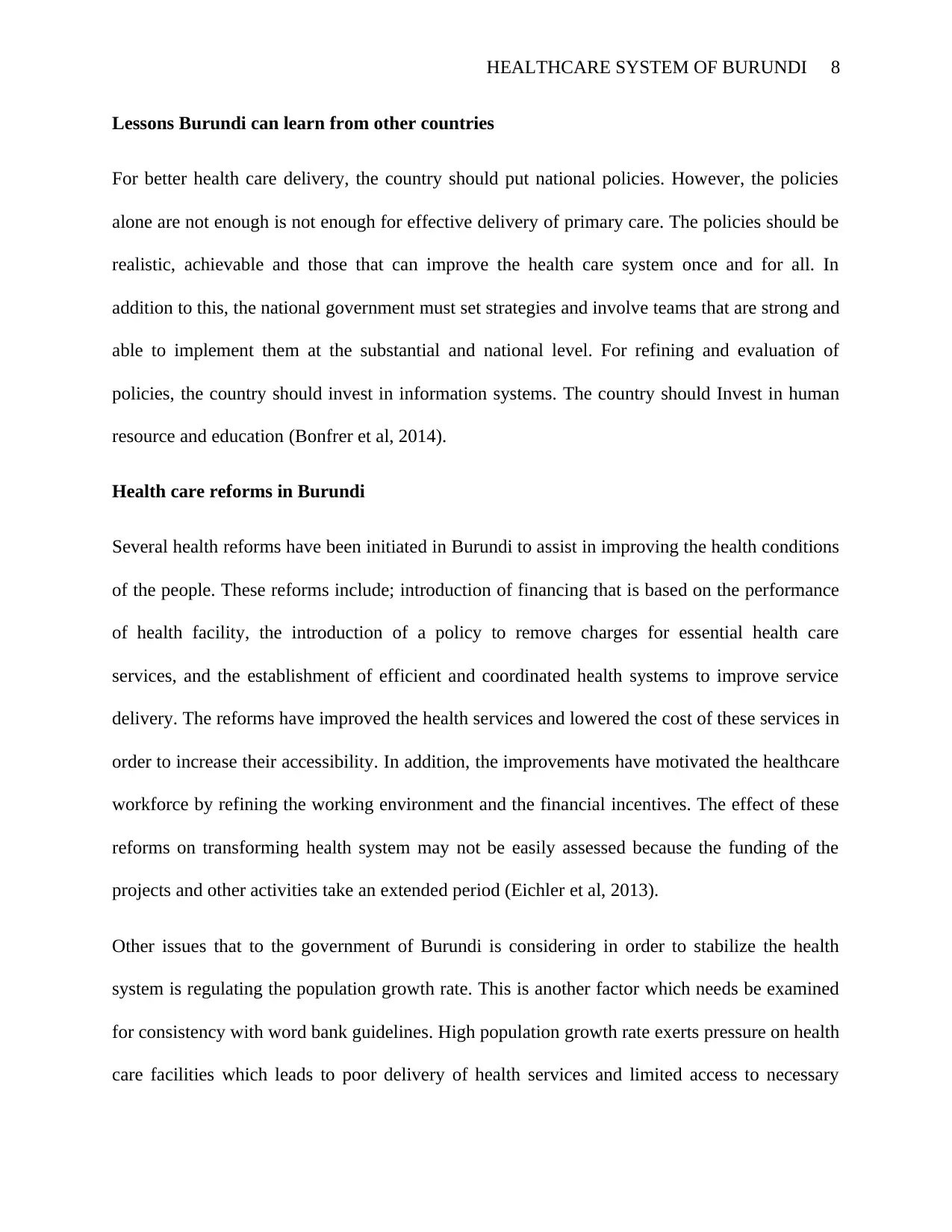
HEALTHCARE SYSTEM OF BURUNDI 8
Lessons Burundi can learn from other countries
For better health care delivery, the country should put national policies. However, the policies
alone are not enough is not enough for effective delivery of primary care. The policies should be
realistic, achievable and those that can improve the health care system once and for all. In
addition to this, the national government must set strategies and involve teams that are strong and
able to implement them at the substantial and national level. For refining and evaluation of
policies, the country should invest in information systems. The country should Invest in human
resource and education (Bonfrer et al, 2014).
Health care reforms in Burundi
Several health reforms have been initiated in Burundi to assist in improving the health conditions
of the people. These reforms include; introduction of financing that is based on the performance
of health facility, the introduction of a policy to remove charges for essential health care
services, and the establishment of efficient and coordinated health systems to improve service
delivery. The reforms have improved the health services and lowered the cost of these services in
order to increase their accessibility. In addition, the improvements have motivated the healthcare
workforce by refining the working environment and the financial incentives. The effect of these
reforms on transforming health system may not be easily assessed because the funding of the
projects and other activities take an extended period (Eichler et al, 2013).
Other issues that to the government of Burundi is considering in order to stabilize the health
system is regulating the population growth rate. This is another factor which needs be examined
for consistency with word bank guidelines. High population growth rate exerts pressure on health
care facilities which leads to poor delivery of health services and limited access to necessary
Lessons Burundi can learn from other countries
For better health care delivery, the country should put national policies. However, the policies
alone are not enough is not enough for effective delivery of primary care. The policies should be
realistic, achievable and those that can improve the health care system once and for all. In
addition to this, the national government must set strategies and involve teams that are strong and
able to implement them at the substantial and national level. For refining and evaluation of
policies, the country should invest in information systems. The country should Invest in human
resource and education (Bonfrer et al, 2014).
Health care reforms in Burundi
Several health reforms have been initiated in Burundi to assist in improving the health conditions
of the people. These reforms include; introduction of financing that is based on the performance
of health facility, the introduction of a policy to remove charges for essential health care
services, and the establishment of efficient and coordinated health systems to improve service
delivery. The reforms have improved the health services and lowered the cost of these services in
order to increase their accessibility. In addition, the improvements have motivated the healthcare
workforce by refining the working environment and the financial incentives. The effect of these
reforms on transforming health system may not be easily assessed because the funding of the
projects and other activities take an extended period (Eichler et al, 2013).
Other issues that to the government of Burundi is considering in order to stabilize the health
system is regulating the population growth rate. This is another factor which needs be examined
for consistency with word bank guidelines. High population growth rate exerts pressure on health
care facilities which leads to poor delivery of health services and limited access to necessary
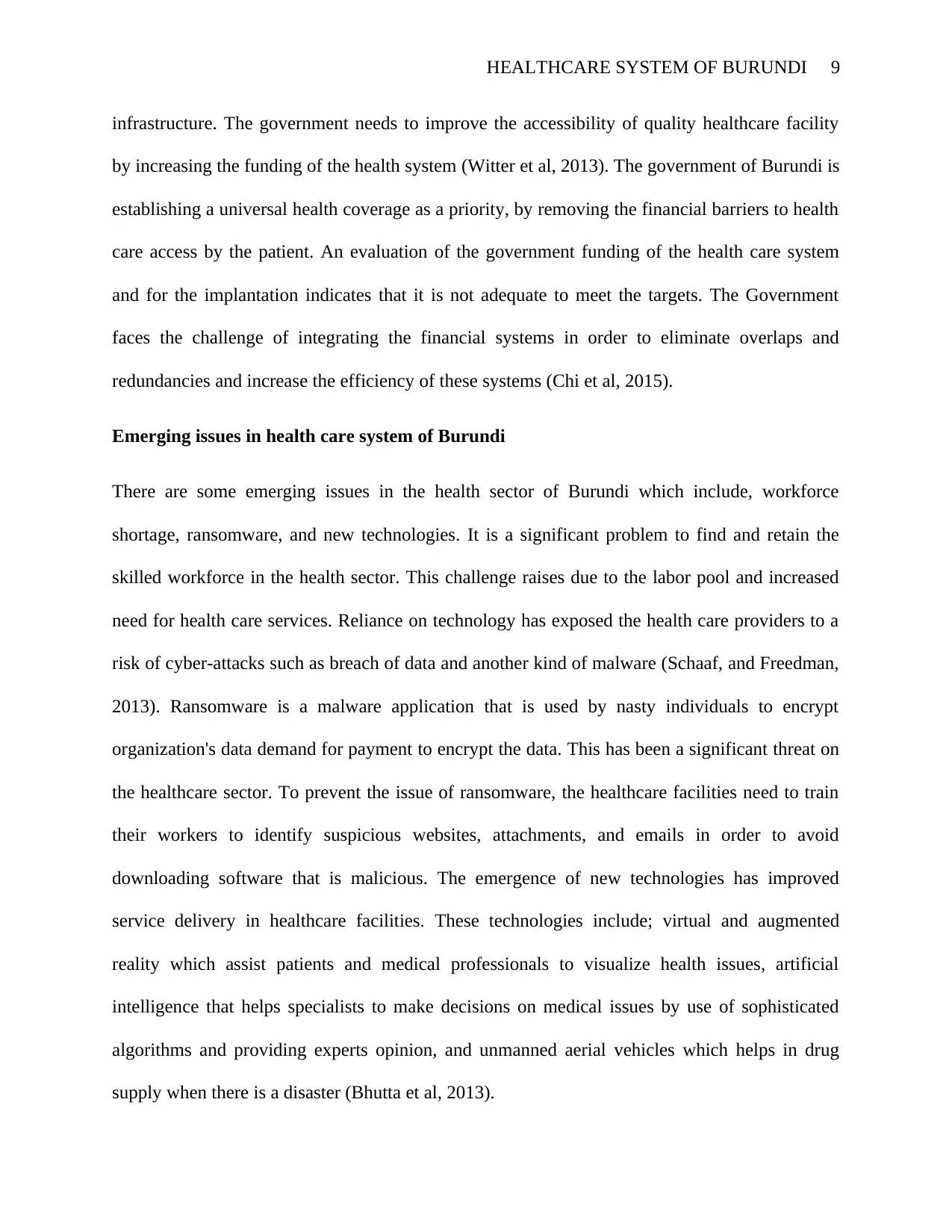
HEALTHCARE SYSTEM OF BURUNDI 9
infrastructure. The government needs to improve the accessibility of quality healthcare facility
by increasing the funding of the health system (Witter et al, 2013). The government of Burundi is
establishing a universal health coverage as a priority, by removing the financial barriers to health
care access by the patient. An evaluation of the government funding of the health care system
and for the implantation indicates that it is not adequate to meet the targets. The Government
faces the challenge of integrating the financial systems in order to eliminate overlaps and
redundancies and increase the efficiency of these systems (Chi et al, 2015).
Emerging issues in health care system of Burundi
There are some emerging issues in the health sector of Burundi which include, workforce
shortage, ransomware, and new technologies. It is a significant problem to find and retain the
skilled workforce in the health sector. This challenge raises due to the labor pool and increased
need for health care services. Reliance on technology has exposed the health care providers to a
risk of cyber-attacks such as breach of data and another kind of malware (Schaaf, and Freedman,
2013). Ransomware is a malware application that is used by nasty individuals to encrypt
organization's data demand for payment to encrypt the data. This has been a significant threat on
the healthcare sector. To prevent the issue of ransomware, the healthcare facilities need to train
their workers to identify suspicious websites, attachments, and emails in order to avoid
downloading software that is malicious. The emergence of new technologies has improved
service delivery in healthcare facilities. These technologies include; virtual and augmented
reality which assist patients and medical professionals to visualize health issues, artificial
intelligence that helps specialists to make decisions on medical issues by use of sophisticated
algorithms and providing experts opinion, and unmanned aerial vehicles which helps in drug
supply when there is a disaster (Bhutta et al, 2013).
infrastructure. The government needs to improve the accessibility of quality healthcare facility
by increasing the funding of the health system (Witter et al, 2013). The government of Burundi is
establishing a universal health coverage as a priority, by removing the financial barriers to health
care access by the patient. An evaluation of the government funding of the health care system
and for the implantation indicates that it is not adequate to meet the targets. The Government
faces the challenge of integrating the financial systems in order to eliminate overlaps and
redundancies and increase the efficiency of these systems (Chi et al, 2015).
Emerging issues in health care system of Burundi
There are some emerging issues in the health sector of Burundi which include, workforce
shortage, ransomware, and new technologies. It is a significant problem to find and retain the
skilled workforce in the health sector. This challenge raises due to the labor pool and increased
need for health care services. Reliance on technology has exposed the health care providers to a
risk of cyber-attacks such as breach of data and another kind of malware (Schaaf, and Freedman,
2013). Ransomware is a malware application that is used by nasty individuals to encrypt
organization's data demand for payment to encrypt the data. This has been a significant threat on
the healthcare sector. To prevent the issue of ransomware, the healthcare facilities need to train
their workers to identify suspicious websites, attachments, and emails in order to avoid
downloading software that is malicious. The emergence of new technologies has improved
service delivery in healthcare facilities. These technologies include; virtual and augmented
reality which assist patients and medical professionals to visualize health issues, artificial
intelligence that helps specialists to make decisions on medical issues by use of sophisticated
algorithms and providing experts opinion, and unmanned aerial vehicles which helps in drug
supply when there is a disaster (Bhutta et al, 2013).
⊘ This is a preview!⊘
Do you want full access?
Subscribe today to unlock all pages.

Trusted by 1+ million students worldwide
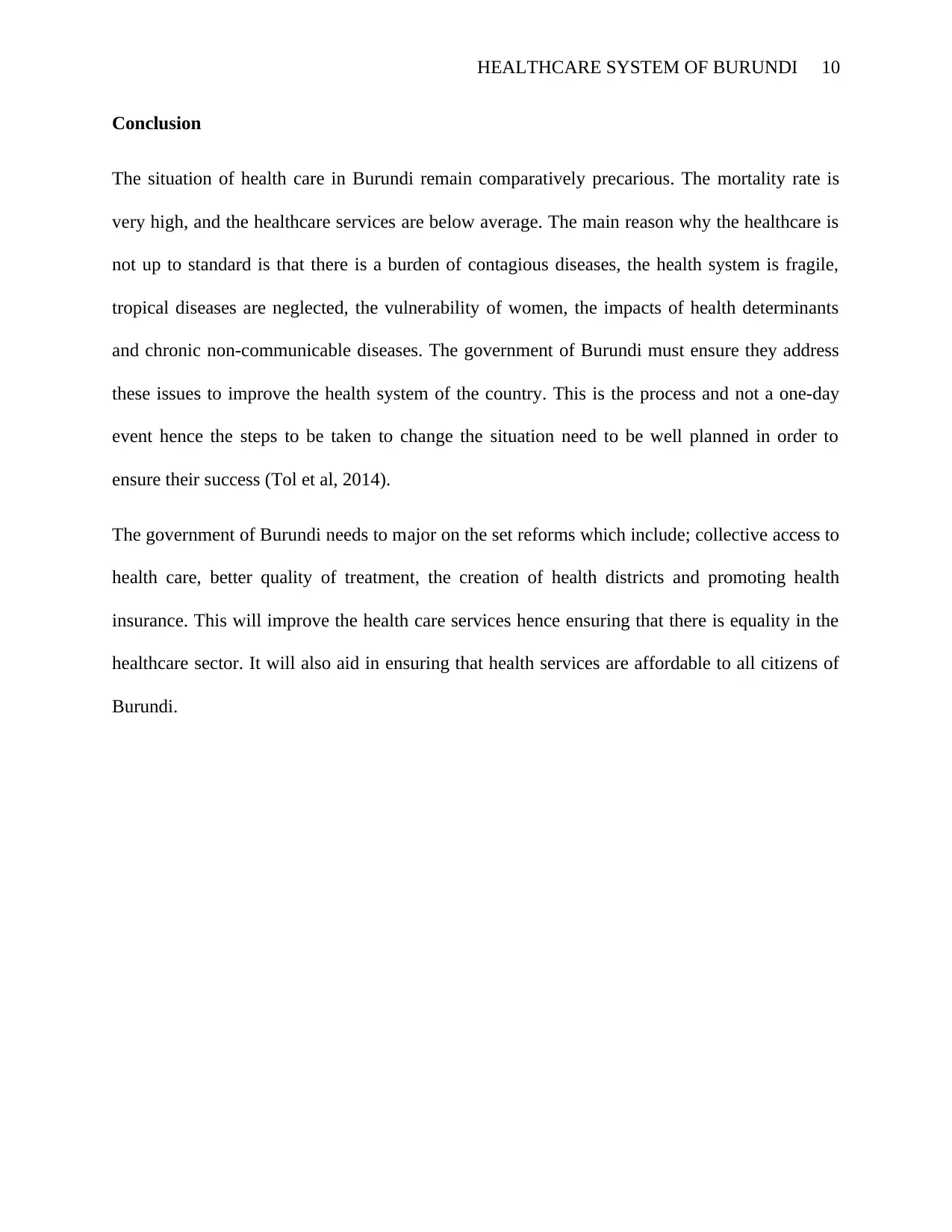
HEALTHCARE SYSTEM OF BURUNDI 10
Conclusion
The situation of health care in Burundi remain comparatively precarious. The mortality rate is
very high, and the healthcare services are below average. The main reason why the healthcare is
not up to standard is that there is a burden of contagious diseases, the health system is fragile,
tropical diseases are neglected, the vulnerability of women, the impacts of health determinants
and chronic non-communicable diseases. The government of Burundi must ensure they address
these issues to improve the health system of the country. This is the process and not a one-day
event hence the steps to be taken to change the situation need to be well planned in order to
ensure their success (Tol et al, 2014).
The government of Burundi needs to major on the set reforms which include; collective access to
health care, better quality of treatment, the creation of health districts and promoting health
insurance. This will improve the health care services hence ensuring that there is equality in the
healthcare sector. It will also aid in ensuring that health services are affordable to all citizens of
Burundi.
Conclusion
The situation of health care in Burundi remain comparatively precarious. The mortality rate is
very high, and the healthcare services are below average. The main reason why the healthcare is
not up to standard is that there is a burden of contagious diseases, the health system is fragile,
tropical diseases are neglected, the vulnerability of women, the impacts of health determinants
and chronic non-communicable diseases. The government of Burundi must ensure they address
these issues to improve the health system of the country. This is the process and not a one-day
event hence the steps to be taken to change the situation need to be well planned in order to
ensure their success (Tol et al, 2014).
The government of Burundi needs to major on the set reforms which include; collective access to
health care, better quality of treatment, the creation of health districts and promoting health
insurance. This will improve the health care services hence ensuring that there is equality in the
healthcare sector. It will also aid in ensuring that health services are affordable to all citizens of
Burundi.
Paraphrase This Document
Need a fresh take? Get an instant paraphrase of this document with our AI Paraphraser

HEALTHCARE SYSTEM OF BURUNDI 11
References
Bertone, M.P. and Meessen, B., 2012. Studying the link between institutions and health system
performance: a framework and an illustration with the analysis of two performance-based
financing schemes in Burundi. Health policy and planning, 28(8), pp.847-857.
Bhutta, Z.A., Das, J.K., Rizvi, A., Gaffey, M.F., Walker, N., Horton, S., Webb, P., Lartey, A.,
Black, R.E., Group, T.L.N.I.R. and Maternal and Child Nutrition Study Group, 2013. Evidence-
based interventions for improvement of maternal and child nutrition: what can be done and at
what cost?. The lancet, 382(9890), pp.452-477.
Bonfrer, I., Soeters, R., Van de Poel, E., Basenya, O., Longin, G., van de Looij, F. and van
Doorslaer, E., 2014. Introduction of performance-based financing in Burundi was associated
with improvements in care and quality. Health Affairs, 33(12), pp.2179-2187.
Bosch-Capblanch, X., Lavis, J.N., Lewin, S., Atun, R., Røttingen, J.A., Dröschel, D., Beck, L.,
Abalos, E., El-Jardali, F., Gilson, L. and Oliver, S., 2012. Guidance for evidence-informed
policies about health systems: rationale for and challenges of guidance development. PLoS
medicine, 9(3), p.e1001185.
Chi, P.C., Bulage, P., Urdal, H. and Sundby, J., 2015. A qualitative study exploring the
determinants of maternal health service uptake in post-conflict Burundi and Northern Uganda.
BMC pregnancy and childbirth, 15(1), p.18.
References
Bertone, M.P. and Meessen, B., 2012. Studying the link between institutions and health system
performance: a framework and an illustration with the analysis of two performance-based
financing schemes in Burundi. Health policy and planning, 28(8), pp.847-857.
Bhutta, Z.A., Das, J.K., Rizvi, A., Gaffey, M.F., Walker, N., Horton, S., Webb, P., Lartey, A.,
Black, R.E., Group, T.L.N.I.R. and Maternal and Child Nutrition Study Group, 2013. Evidence-
based interventions for improvement of maternal and child nutrition: what can be done and at
what cost?. The lancet, 382(9890), pp.452-477.
Bonfrer, I., Soeters, R., Van de Poel, E., Basenya, O., Longin, G., van de Looij, F. and van
Doorslaer, E., 2014. Introduction of performance-based financing in Burundi was associated
with improvements in care and quality. Health Affairs, 33(12), pp.2179-2187.
Bosch-Capblanch, X., Lavis, J.N., Lewin, S., Atun, R., Røttingen, J.A., Dröschel, D., Beck, L.,
Abalos, E., El-Jardali, F., Gilson, L. and Oliver, S., 2012. Guidance for evidence-informed
policies about health systems: rationale for and challenges of guidance development. PLoS
medicine, 9(3), p.e1001185.
Chi, P.C., Bulage, P., Urdal, H. and Sundby, J., 2015. A qualitative study exploring the
determinants of maternal health service uptake in post-conflict Burundi and Northern Uganda.
BMC pregnancy and childbirth, 15(1), p.18.
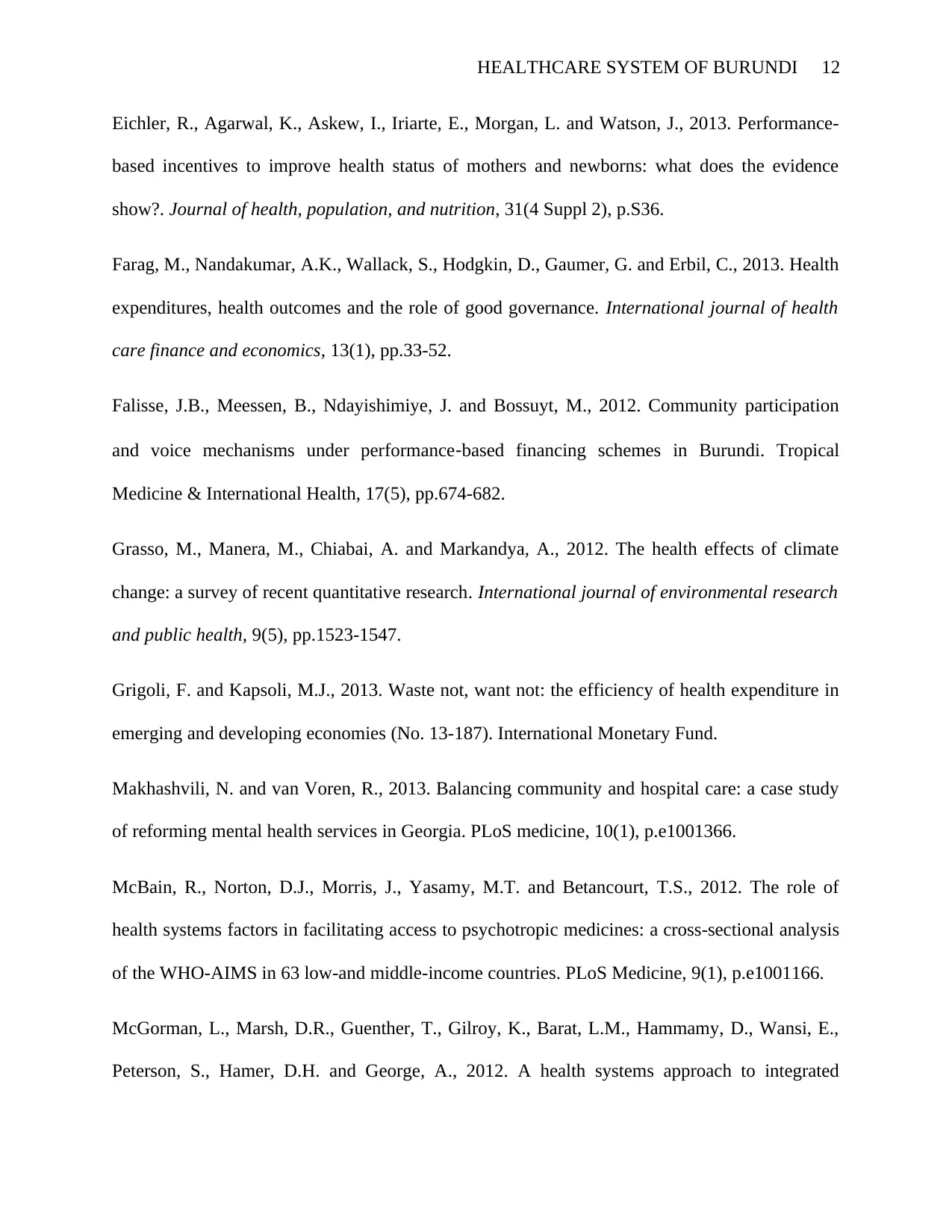
HEALTHCARE SYSTEM OF BURUNDI 12
Eichler, R., Agarwal, K., Askew, I., Iriarte, E., Morgan, L. and Watson, J., 2013. Performance-
based incentives to improve health status of mothers and newborns: what does the evidence
show?. Journal of health, population, and nutrition, 31(4 Suppl 2), p.S36.
Farag, M., Nandakumar, A.K., Wallack, S., Hodgkin, D., Gaumer, G. and Erbil, C., 2013. Health
expenditures, health outcomes and the role of good governance. International journal of health
care finance and economics, 13(1), pp.33-52.
Falisse, J.B., Meessen, B., Ndayishimiye, J. and Bossuyt, M., 2012. Community participation
and voice mechanisms under performance‐based financing schemes in Burundi. Tropical
Medicine & International Health, 17(5), pp.674-682.
Grasso, M., Manera, M., Chiabai, A. and Markandya, A., 2012. The health effects of climate
change: a survey of recent quantitative research. International journal of environmental research
and public health, 9(5), pp.1523-1547.
Grigoli, F. and Kapsoli, M.J., 2013. Waste not, want not: the efficiency of health expenditure in
emerging and developing economies (No. 13-187). International Monetary Fund.
Makhashvili, N. and van Voren, R., 2013. Balancing community and hospital care: a case study
of reforming mental health services in Georgia. PLoS medicine, 10(1), p.e1001366.
McBain, R., Norton, D.J., Morris, J., Yasamy, M.T. and Betancourt, T.S., 2012. The role of
health systems factors in facilitating access to psychotropic medicines: a cross-sectional analysis
of the WHO-AIMS in 63 low-and middle-income countries. PLoS Medicine, 9(1), p.e1001166.
McGorman, L., Marsh, D.R., Guenther, T., Gilroy, K., Barat, L.M., Hammamy, D., Wansi, E.,
Peterson, S., Hamer, D.H. and George, A., 2012. A health systems approach to integrated
Eichler, R., Agarwal, K., Askew, I., Iriarte, E., Morgan, L. and Watson, J., 2013. Performance-
based incentives to improve health status of mothers and newborns: what does the evidence
show?. Journal of health, population, and nutrition, 31(4 Suppl 2), p.S36.
Farag, M., Nandakumar, A.K., Wallack, S., Hodgkin, D., Gaumer, G. and Erbil, C., 2013. Health
expenditures, health outcomes and the role of good governance. International journal of health
care finance and economics, 13(1), pp.33-52.
Falisse, J.B., Meessen, B., Ndayishimiye, J. and Bossuyt, M., 2012. Community participation
and voice mechanisms under performance‐based financing schemes in Burundi. Tropical
Medicine & International Health, 17(5), pp.674-682.
Grasso, M., Manera, M., Chiabai, A. and Markandya, A., 2012. The health effects of climate
change: a survey of recent quantitative research. International journal of environmental research
and public health, 9(5), pp.1523-1547.
Grigoli, F. and Kapsoli, M.J., 2013. Waste not, want not: the efficiency of health expenditure in
emerging and developing economies (No. 13-187). International Monetary Fund.
Makhashvili, N. and van Voren, R., 2013. Balancing community and hospital care: a case study
of reforming mental health services in Georgia. PLoS medicine, 10(1), p.e1001366.
McBain, R., Norton, D.J., Morris, J., Yasamy, M.T. and Betancourt, T.S., 2012. The role of
health systems factors in facilitating access to psychotropic medicines: a cross-sectional analysis
of the WHO-AIMS in 63 low-and middle-income countries. PLoS Medicine, 9(1), p.e1001166.
McGorman, L., Marsh, D.R., Guenther, T., Gilroy, K., Barat, L.M., Hammamy, D., Wansi, E.,
Peterson, S., Hamer, D.H. and George, A., 2012. A health systems approach to integrated
⊘ This is a preview!⊘
Do you want full access?
Subscribe today to unlock all pages.

Trusted by 1+ million students worldwide
1 out of 14
Related Documents
Your All-in-One AI-Powered Toolkit for Academic Success.
+13062052269
info@desklib.com
Available 24*7 on WhatsApp / Email
![[object Object]](/_next/static/media/star-bottom.7253800d.svg)
Unlock your academic potential
Copyright © 2020–2026 A2Z Services. All Rights Reserved. Developed and managed by ZUCOL.




